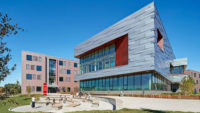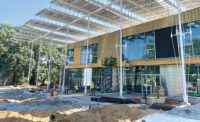While the U.S. Green Building Council is busy making a business case for a greener globe, other environmentalists are busy making greener buildings, communities and cities.
The green building market is expected to valued at more than $3 billion by 2020, according to USGBC.“Profitability is sustainable and sustainability is profitable,” said Rick Fedrizzi, the USGBC’s CEO and founding chair, at the 2015 Greenbuild International Conference and Expo, held Nov. 18-20 in Washington, D.C. “Green mutual funds outperform others,” he added.
Fedrizzi is trying to dispel the “Old World view that environmentalism and capitalism are opposed.” Beyond Greenbuild, the message is repeated in his new book, "Greenthink: How Profit Can Save the Planet," just published by Disruption Books. All proceeds from sales of the book, available at Amazon for $11.69 in paperback or $7.99 for Kindle, benefit Project Haiti Orphanage and Children’s Center and the Center for Green Schools.
At Greenbuild, Douglas Hollett, U.S. Dept. of Energy Office of Energy Efficiency and Renewable Energy (EERE) Deputy Assistant Secretary for Renewable Power, said, “We are in the middle of an energy revolution,” with LED lighting, smart buildings, rapid cost reduction in solar and wind energy. In 2012, cumulative installed solar photovoltaic capacity grew more than 83% and cumulative installed wind capacity increased by nearly 28% from the previous year, according to DOE statistics.
Hollett spoke at the EMerge Alliance’s unplugging ceremony, when 20 exhibit booths went from utility power to solar power from the group’s building-level microgrid. EMerge is a nonprofit, open network of more than 100 organizations that develop standards for the efficient use of hybrid power in residential and commercial buildings and throughout campuses. The installation was designed using EMerge Alliance’s standards for the hybrid use of alternating current and direct current in buildings.
The demonstration included three arrays of various solar technologies installed on the street level outside the Walter E. Washington Convention Center. The arrays were directly coupled with battery storage technologies on a direct current bus. Three different energy conversion and management systems powered the booths.
Also in the exhibit hall, Unity Homes, the nonprofit Cradle to Cradle Products Innovation Institute and Builder magazine, published by Hanley Wood, gave tours of its net-zero annual energy-use manufactured house, assembled in the three-and-a-half days leading up to the conference.
The super-green, 1,620-sq-ft house was prefabricated in Unity Homes’s Walpole, N.H., plant, broken down into 50 components, packed up and shipped to the convention. The house was planned, designed, constructed, inspected and tested according to the USGBC’s LEED for Homes Version 4 program requirements. The single-story house, when moved to its permanent site in New Hampshire, is on course to be certified LEED Platinum—the highest level of the green-building rating system.
A typical Unity house takes 30 to 35 days to assemble on site, said the maker. According to the company, the prefabricated house can be adapted to multifamily and multistory developments.
At the conference, the Building and Construction Authority (BCA) of Singapore said the world’s first high-rise rotatable laboratory to test various integrated green building systems—including curtain walls—in tropical climates will be finished in April.
BCA is investing in SkyLab because “we want to look for more cost-effective solutions for green buildings in the tropics,” said John Keung, BCA’s CEO. “We need to achieve some breakthroughs in the tropics. SkyLab is a golden opportunity.”
The single-test-bed lab was developed in collaboration with the Lawrence Berkeley National Laboratory and modeled after LBNL’s rotatable test-bed of its Facility for Low-Energy Experiments in Buildings. Unlike FLEXLAB, which is at grade, SkyLab is atop a six-story building at the BCA’s $36.7-million Building Energy Efficiency RD&D Hub.
In other green building developments, Joel Cesare, sustainable building advisor in Santa Monica, Calif.’s office of sustainability and the environment, said the city is on course to build the nation’s first municipal building to meet the highest level of certification of the most rigorous green-building certification program—the Living Building Challenge (LBC) of the International Living Future Institute.
“This is a paradigm shift from a building that is a resource consumer to one that is a resource producer,” said Cesare.
The 60,000-sq-ft project, currently half way through schematic design, is modeled after Seattle’s 52,000-sq-ft Bullitt Center—itself considered the world’s greenest speculative office building, if not the world’s greenest building.
“We were inspired by Bullitt Center and how it treats its waste,” said Cesare. “The only way we could meet the LBC was by using composting toilets.”
In another sustainability shift for a U.S. building, Lend Lease is nearly finished developing and constructing the first U.S. hotel framed using mass timber. The four-story building is at the U.S. Army’s Redstone Arsenal in Alabama.
The hotel contains cross-laminated timber walls and decks, and glue-laminated columns and beams. CLT is an engineered wood product that consists of layers of boards glued together under pressure with the grain of the boards in one layer running perpendicular to the grain of the other layers.
Mass timber is considered a sustainable building material because it sequesters carbon and is renewable. But the material has other advantages, said Jeff Morrow, Lend Lease’s program. “A CLT building is a lot like a Lincoln Log set,” he said.
Components are prefabricated, flat-packed and shipped to the site in order of construction. Normally, it would take 26 carpenters 16 to 17 weeks to erect the structure of a building using conventional materials, said Morrow. At Red Stone Arsenal, it took 11 workers, 11 weeks.
“Three of the crew were carpenters and eight were laborers—Army veterans with little or no construction knowledge that we trained,” said Morrow.
At the conference, Fedrizzi, who will be retiring from the USGBC at the end of 2016, introduced his successor. Mahesh Ramanujam, currently COO, will take over as CEO of both USGBC and the associated U.S. Green Business Certification Inc.
Fedrizzi also issued a call for action. “We must raise our collective voices louder in the next 12 months, during the presidential campaign, to convince the candidates that sustainability is the most important [issue],” he said, adding, “Climate change is insidious because it’s the first problem that requires international cooperation [to solve].”








Post a comment to this article
Report Abusive Comment